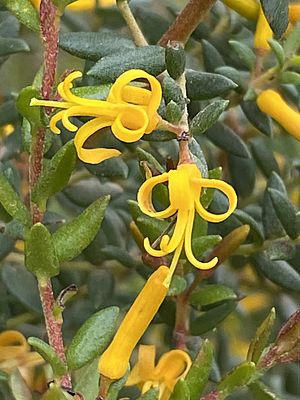Soft geebung facts for kids
Quick facts for kids Soft geebung |
|
|---|---|
 |
|
| Persoonia mollis subsp. livens Penrose National Park | |
| Scientific classification | |
| Genus: |
Persoonia
|
| Species: |
mollis
|
| Synonyms | |
|
|
The Persoonia mollis, also known as soft geebung, is a special plant found only in New South Wales, Australia. It belongs to the Proteaceae plant family. This plant can be a small bush or a larger shrub. It has interesting leaves and pretty yellow flowers.
What Does It Look Like?
The soft geebung is a shrub that can grow from about 20 centimeters (8 inches) to 5 meters (16 feet) tall. It has smooth bark. Its young branches are covered in soft, grey or rust-colored hairs.
Its leaves can be long and thin, oval-shaped, or spoon-shaped. They are usually between 1.5 and 12 centimeters (0.6 to 4.7 inches) long. The underside of the leaves is much lighter in color.
The flowers are yellow and grow in groups of up to thirty. They are found along a stem called a rachis, which can be up to 15 centimeters (6 inches) long. Each flower sits on a small stalk called a pedicel. The flower parts, called tepals, are yellow and hairy on the outside. They are about 8 to 11.5 millimeters (0.3 to 0.5 inches) long.
Soft geebung plants usually flower from late December to May. After flowering, they produce a green fruit. This fruit is a type of drupe, which means it has a hard pit inside, like a peach. It's about 8 millimeters (0.3 inches) long and 7 millimeters (0.3 inches) wide.
How It Was Named
The soft geebung was first officially described in 1810 by a botanist named Robert Brown. He wrote about it in a scientific publication called Transactions of the Linnean Society of London.
Later, in 1991, two scientists, Siegfried Krauss and Lawrie Johnson, studied the plant more closely. They found that there are nine different types, or "subspecies," of Persoonia mollis. These subspecies are slightly different from each other, often in their size, leaf shape, or where they grow. All these subspecies are recognized by the Australian Plant Census.
Where It Grows
The soft geebung grows in various places, from open heathlands to forests. It usually prefers sandy soils, especially those made from sandstone. You can find it from the Blue Mountains and Hawkesbury River area, stretching south towards the Clyde River.
Each of the nine subspecies tends to grow in specific areas:
- Some subspecies grow in woodlands and forests, like the one found in the Budawang Range.
- Others prefer forests near the coast, such as between Jervis Bay and Durras Lake.
- Some are found in areas like Kangaloon and the Shoalhaven River, growing on Hawkesbury Sandstone.
- Certain types grow in heath and forest on different kinds of sandstone, for example, between the Shoalhaven River and Nowra.
- One subspecies grows in woodlands near Penrose, Goulburn, and Braidwood, often on rocky ground.
- Another type is found in forests on Hawkesbury sandstone in the Cowan-Hornsby area.
- The original mollis subspecies grows in forests within the Blue Mountains.
- Some subspecies grow in forests near Oakdale and the Illawarra Escarpment.
- Finally, one type is a low, spreading shrub found in forests on Hawkesbury sandstone between Nattai Gorge and Canyonleigh.
Images for kids


